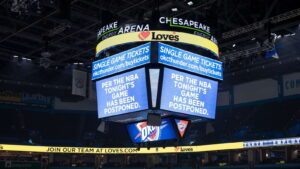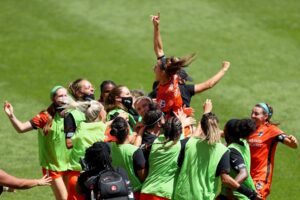by The Cowl Editor on September 3, 2020
Sports
by Cam Smith ’21
Sports Co-Editor
Late in the evening of March 11, 2020, life in the United States changed forever. In the span of 45 minutes, President Donald Trump announced a travel ban on European countries, actor Tom Hanks declared he was infected with COVID-19, and the National Basketball Association suspended its season indefinitely. The pandemic became real for Americans in these 45 minutes. No longer a mystery disease confined to a far-off continent, it was now an invading virus.
Though all three of these events woke America up to the impending threat, it seemed almost as if the NBA’s cancellation shook the nation the most. Sports have been a constant throughout the lives of every American in the modern day. They have been there through tragedies ranging from 9/11 to the Boston Marathon bombings. Sports are a unifying force, a way to disconnect from the hardships of life and a way to come together despite individual differences. So, when they abruptly disappeared, the country finally realized the scale of the problem at hand.

Almost immediately after the major leagues were indefinitely suspended, people started to think about what they would look like upon their return. Many hoped the seasons could just resume a month later, once the virus had been contained. Unfortunately, that containment never came.
Instead, it became clear that fans would not be allowed at games when the leagues did restart. Some even started floating the ideas of possible “bubbles,” where the entire league would be confined to one complex. No one would be allowed to leave the designated area, and testing would occur almost daily. The hope was that if there was no contact with the outside world, COVID-19 would never be able to make it in.
Major League Baseball seemed to discuss this idea first, with a possible “Arizona League” in Phoenix, Arizona. The idea was quickly shot down by players, however, as they lamented having to stay away from their families for months.
The bubble idea caught on elsewhere, however, and in late June, the National Women’s Soccer League became the first American professional sports league to resume play. The NWSL hosted the 2020 Challenge Cup, a tournament featuring eight teams and 23 games. The tournament was a remarkable success, both on and off the field. Once in the Utah-based bubble, over 2,000 tests were doled out to both players and staff members alike. Not a single one came back positive.
The NBA and NHL soon followed suit, and by the end of July both had resumed their seasons in bubbles of their own. Basketball resumed at the Walt Disney Resort in Orlando, Florida while the NHL fled north of the border to Canada. Luckily, a few cases were caught upon arrival to the bubbles and as of now, not a single case has been detected in either leagues’ bubbles since the start of play. Both leagues have also shown surprisingly high-quality products on the court and on the ice, as the athletes have seemingly not missed a beat even after the long layoff.

Indeed, the bubbles have shown to be remarkable success stories, blueprints for sports during a pandemic. Meanwhile, the MLB has embarrassingly stumbled along without one even after being the first league to raise the possibility of a bubble. Their decision not to enfore a bubble has been nothing but an abject failure.
Just a mere week into the start of the season, COVID-19 outbreaks had already hit several different teams, forcing them to cancel entire series of games. Reports began to leak about players visiting clubs and casinos. With no bubble to speak of, teams continued to fly across the country, exposing themselves and others to the virus every time they were forced to travel.
Sport Illustrated’s Stephanie Apstein summed it up perfectly by saying, “the protocols are woefully inadequate, so the weak spot could be anywhere. It will be almost impossible for the league to identify it definitively—which is one of the challenges of playing baseball outside of a bubble during a pandemic in the country with one of the world’s worst responses.”
The league has continued to saunter on, however, seeing very few changes to its protocols at all. The delays continue, as just last weekend the Houston Astros and Oakland Athletics game was postponed after a positive test in the A’s organization. Instead of admitting failure and cancelling the season, Commissioner Rob Manfred and the rest of the MLB have dug their heels in. And by doing so, they have put the communities they play in at risk.
On the horizon now looms the start of both the NFL and college sports. Even after witnessing the failures of the MLB, the NFL has decided not to use a bubble. That decision could spell disaster for a sport that features the largest rosters of any of the professional sports and is likely the one with the most physical contact. Perhaps the NFL simply does not care about the spread of COVID-19, as the MLB has shown not to.
College sports face even more complex challenges and risks, as bubbles are much harder to pull off for student-athletes who still need to attend class. At the same time, no bubbles mean that student-athletes will be forced to travel around to other campuses and communities. They would then return to their own campuses, potentially breaking the tight seals that colleges across the country are working so hard to keep.
Indeed, the sports world and the rest of the world at large have come a long way since that fateful March 11 night. But, one thing is abundantly clear: if you want to safely play sports during a pandemic, the bubble is king.